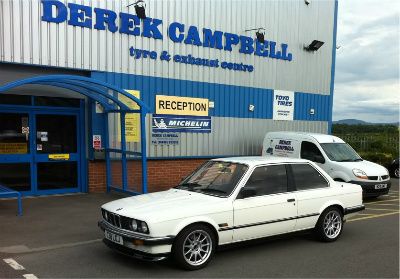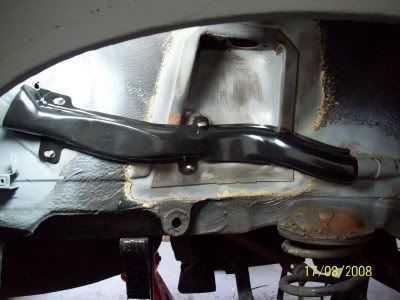Before we kick off this update it's probably worth mentioning that I've had a very
polite e-mail informing me that I've somehow managed to make a complete balls up
of explaining how a VR cranksensor actually works in the last update.
So, I've taken the time to do some intensive research into the workings of a VR sensor
and get a better understanding of it, so that I might be able to pass the knowledge on.
The VR sensor works by................................... nah, still can't figure it out.
Moving on..............
With all the main inputs taken care of, the ecu can now get it's arse in gear and
start to earn it's living. Once it's checked over the incoming sensor info it
can then decide how much fuel to squirt in and when to fire the spark.
First up for us is the spark.
With the standard management system there's quite a few components involved
in the job of getting the spark created, and then, carrying it down to the sparkplug
to set off the bang.
First up, the standard ignition coil......

The coil is fed a constant 12 volts once the ignition is switched on and
then the ecu switches the coils earth wire on and off to create a nice fat whack of voltage.
Once the ecu has trigged the coil the high voltage travels out and into the high tension lead.........

Which carries it all the way up the the distributor cap, whereupon it enters through the bottom
port..........

Once at the distributor cap the voltage travels inside and passes
over onto the centre of the spinning rotor arm............

As the rotor arm is bolted onto the end of the camshaft it's spinning around
with the engine. And once the tip of the rotor arm lines up with one of the
brass poles on the inside of the distributor cap the voltage takes a leap
and is off on it's way again.........


After jumping to the brass pole it's off out to that cylinders HT lead.......


(picture borrowed from Google)
And finally after travelling down the HT lead it reaches the sparkplug,
where upon it completes it's journey by jumping to the earth probe of the sparkplug
and the resulting spark lights the booom.......

I know, I know, pure Einstein stuff, but bare with me.
All of this works perfect on a standard engine, and, even a highly
modified one if the truth be told.
So, as you'd expect, I've gone an fu*ked with it.
What you see below is what's sometimes referred to as a "wasted spark"
coil........

As the new Dta ecu now fitted to the car gives me the option to use one
of these I'm going to run with it.
Probably worth a few words on how it works before explaining why I've chosen
to go this route.
The coil shown above while looking like one chunky fat unit is
actually two separate coils moulded into one unit.........

The ecu can either trigger a spark from the red coil or the green coil.
As you can see in the pic above each half of the coil has two connections
for HT leads. The leads for cylinder 1 and 4 are connected into the green
half and cylinders 2 and 3 into the red half......

When a spark is required in cylinder 1 the ecu fires the green half of the coil
and the two leads plugged into this half both get the large whack of voltage.
The result is both the sparkplugs in cylinder 1 and 4 fire at the same time.
The spark for cylinder 1 arrives and sets off the ignition of the compressed
fuel and air in this cylinder, while further down the block the spark also
arrives in cylinder 4. However as this cylinder is just pumping out burnt exhaust
gases at the moment when the spark goes off it does nothing.
This is the same process every time a spark is needed. The ecu will trigger
whichever half of the coil that sends the voltage to the sparkplug that needs it,
and, it will always travel down the other HT lead connected to this half of the
coil aswell. The voltage that travels down the other lead will always create a spark
in a cylinder thats pumping out exhaust gases and as such will be wasted.
Hence the nick name for this type of ignition system, "wasted spark".
So, thats how I think it works, as always xworks enterprises can not be held responsible for early
life termination as a result of this explanation, all contracts are binding, the price of your shares
can go up as well as down, blah, blah, blah, yada, yada, yada.........
Next logical question would be, why am I choosing to fu*k with an ignition system that works
perfectly well.
And the answer is simple, or to be more accurate, simplify.
With the wasted spark set up shown above all you have is the coil, three wires running to it
from the ecu which power it up and trigger coil A or B, and then a few HT leads to carry
the high voltage down to the spark plugs. And thats it, thats the sub total of our new ignition system.
With the addition of one simple self contained wasted spark coil we've managed to dump the distributor,
the distributor cap and the rotor arm, all of which can be a source of frustrating ignition problems as they age.
And that, in a nutshell, is the reason for going the wasted spark route. No performance advantage, just plain
old reliability.
With all that said, it's almost certain now that this new coil will somehow manage to short out and set the car on fire
just to keep Murphy's Law alive and well.
More pic's, less bull. Here how it all got nailed together.
With the distributor deleted this left the small problem of a gaping hole in the end of the cam box.
Step forward one distributor blanking plate supplied by Massive (link to website earlier in thread)..........

And bolt it on to cover the hole where the distributor used to be........

There is one other slight change which can be noticed in the picture above
and thats the three little studs that used to hold on the distributor and now
hold on the cover plate. They've been replaced with slightly longer studs.
The reason being they've another job to do as well.
Cardboard template............

transferred to aluminium.........

weldy, weldy......

and bolt her up..........














































































































